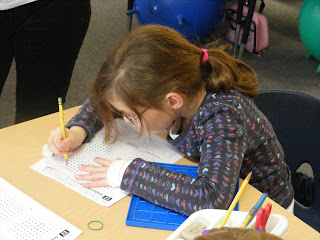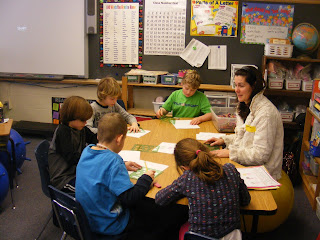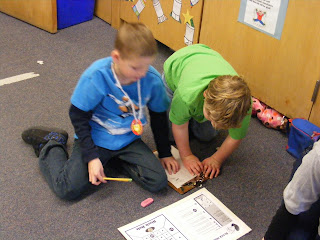Report Cards
By now, you have all seen the January report card. I hope that you found it report card to be helpful, in terms of informing you as to his/her progress thus far in second grade. If you have any questions or concerns, I would be happy to discuss them with you. If you have not signed/returned the report card envelope, please do so as soon as possible! Thank you!
Field Trip
Don't forget that our Field Trip to Mechanics Hall (Worcester) is coming up on Thursday, February 17. Keep an eye out for a reminder - with more information - to come next week!
Thank You
I would just like to say "THANK YOU" to all of you for your continued help and support at home, in the classroom, and with all the generous donations. We've been given emergency snacks, extra glue sticks, more plastic baggies, fabulous prizes for reading logs, and so much more!! A special thank you goes out to Isabelle's mom for donating an aerobic step to our classroom for students to stand on when using the SMARTboard. (It's a lot more sturdy than the stepstool we were using before.) Thank you!
Also, thank you THIS week to the parents that came in for Friday's Math Lab - Mrs. White, Mrs. Edwards, and Mrs. Gilbert - and also to those who volunteered to come in!! I feel very lucky to be working with such a wonderful group of parents...thank you!!
Weekly Update
I did not have a chance to update the blog last week, so I'm hoping to capture both weeks with this update! (I'll try to keep it short and sweet, though!)
READING
Last week, students read a Time For Kids article titled, Super Croc. As you can imagine, this article sparked a great deal of interest and discussion among students and it prompted a new science unit on fossils/dinosaurs!
This week, we read the story, The Alvin Ailey Kids: Dancing As a Team in our reading anthology. This nonfiction story tells about a special dance school in New York City. Suggestion: Ask your child about the three different types of dance students study there. Can they explain/describe them?
For the last two weeks, students have been working to summarize what they read. This is a very difficult skill - even for adults! We have found that it is best to go slow and (depending on the length of the selection) state the main idea of every paragraph or page. Sometimes, we can use the exact words/sentence from the story. Other times, however, we need to use our own words to make sure that we include all the important information. Once we have identified the main idea from every paragraph/page, we put it all together (in order)…and PRESTO - we have a summary! It is a lengthy, and challenging, process – one that every student could use some practice with.
Suggestion: Ask your student to try and summarize a chapter or a few pages from a story that you read together. Help if/when necessary!
SPELLING
Students have been learning all about digraphs for the last two weeks. A digraph is a 2-letter combination in which neither letter “says” its name! Instead, they make a whole new sound! The digraphs with which we are the most familiar are the four "H-brothers"
sh ch th wh
brush lunchbox moth while
shocked chop think what
After learning about these 4 digraphs, students were then introduced to:
"cousin ph" - graph, phrase AND "intruder tch" - match, itching
These digraphs can be tricky when we're not careful! Encourage your child to "hunt" for these "brothers" in their reading and writing!!
GRAMMAR
We have been working on verbs for the past fewweeks. We began by focusing on present-tense verbs (action that is happening right now). Last week, we looked more closely at past-tense verbs (action that has already happened).
When writing/spelling regular past-tense verbs, students should remember that we usually just add –ed to the end.
Examples: I wanted to go to the store. They asked for help.
There are two exceptions to this rule, however:
a) If the verb already ends with e, we just add the d.
Examples: She smiled at the boy. Mom baked cookies.
b) If the verb has a short vowel and ends with a consonant, we need to double the consonant and then add –ed.
Examples: The girl hopped on one foot! The baby hugged his mom.
These rules were introduced several weeks ago, so this should really be more of a review. If you notice that you child still has difficulty applying these rules, please give him/her a little extra practice!
This week, we talked about how some verbs clearly show action and some don’t!
HAVE is one of those verbs that does not show action – but it’s still a verb! Students have been working all week with this verb – learning about all the different variations and tenses (have, has, had) and when to use them.
WRITING
This week, students brainstormed ideas for their own, individual persuasive letter. If you haven’t heard already, the letter is going to you… and I can’t wait for you to read them! J Students should finish up these letters early next week - so, stay "tuned!"
MATH
Last week, we continued on through Unit 6 in the Everyday Math Program: Whole-Number Operations and Number Stories. We focused a lot on comparison number stories and students were introduced to different diagrams as strategies to solve these word problems. Number stories/word problems can be tricky! Keep supporting your child at home!
This week, students have been worki with Base-10 Blocks to solve 2-digit and 3-digit subtraction problems. We started off with fairly easy problems (ones that did not require regrouping) and then moved on to the more challenging problems. See pictures below:
Next week, we will phase-out the blocks and work to solve these problems using the paper-and-pencil algorithm. We call this new procedure the “Trade First” algorithm.
From the paper-and-pencil results, this method looks very similar to what you and I know as “borrowing.” The theory behind it, however, is different and it is important that students understand that what is happening is not “borrowing” (since you don’t return anything when you are done with it) but actually “trading.”
When I was in school, the rule was to “cross out the number in the tens place and put a 1 in front of the number in the ones place.” No one ever told me WHY I was supposed to do it this way, just that if I did…I would get the right answer. The ultimate goal for students, however, is not to get the right answer (although, that would be nice) but to understand WHAT is happening and WHY this method will work.
A tutorial explaining the reasoning behind the Trade-First algorithm was sent home with your child on Tuesday. I have also posted a copy here: https://docs.google.com/viewer?a=v&pid=explorer&chrome=true&srcid=0B0ajY3oA56gsNWM0NTEzNjktN2JkYi00NDBjLWFjNzAtZTIxOTQzY2RlODRi&hl=en&authkey=CLOrxKwC
(as well as on the homework/projects page above).
On Friday, students participated in a Math Lab. As mentioned, we had three parent volunteers. Scroll down to see students busy creating Geoboard Arrays (introduction to multiplication!), Symmetry Books, and playing Black Hole (a subtraction game).
SCIENCE
This week, students had an opportunity to observe real fossils! Working in small groups, students looked and touched real fossils, recording their observations in their science notebooks as they went. They made some interesting discoveries! Ask your child what s/he found! Scroll down to see (more) pictures!
Today, Mrs. DiPietro was our Mystery Reader! It was Anthony's birthday on Thursday and mom's visit was a great present/surprise! Mrs. DiPietro read two fabulous stories: Giraffe and a Half by Shel Silverstein and Skippy Jon Jones in the Doghouse by Judy Schachner. We all felt very lucky to have Mrs. DiPietro stop by Elmwood on her way to India! Thank you so much for coming in!!




























































No comments:
Post a Comment